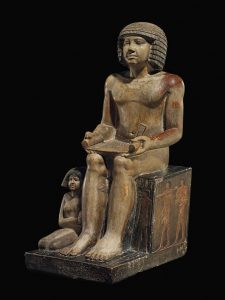Ancient Egypt Art is highly stylized and symbolic as the artists used art to idealize the subject being depicted. Therefore Egyptian paintings seen on tomb walls always conveyed a happy and orderly lifestyle. In Ancient Egypt Art Movement, all figures of humans were depicted as young and healthy.

In ancient Egypt, art is characterized by the use of simple lines and simple shapes. This is to create the concept of order and balance. The figures of humans were drawn in profile traditionally, but with one eye and both shoulders showed frontally. The largest figure that was shown on tomb paintings was of the occupant and it was regardless of the actual height of the deceased.
To maintain correct proportions of the images, horizontal and vertical reference lines were used by artists in order. Due to this, the art style resulted in somewhat affected forms which were otherwise caused by a lack of perspective. Most importantly, this art style was used for thousands of years. There was the only change that came during the transient Armana art period.
Ancient Egyptian Paintings

Traditionally, the colors used in paintings that showed the body of a man was painted as a dark reddish-brown color whereas in paintings the body of a woman was painted as lighter, yellowish-brown color. The differences in colors represented the outdoor life of a man as opposed to the more secluded lifestyle of a woman.
In Ancient Egyptian art, six basic colors were used – red, yellow, white, black, green and blue. For grinding colors, a tiny pestle and mortar were used. All colors had different meanings and were very symbolic.
Red color- It represented life and victory and was also used to convey anger
Yellow color- Yellow was often used to represent gold. It was used to convey that the subject was imperishable and indestructible. This eternal color was used to depict the Sun God
White color- It represented purity, power and greatness, a sacred color
Black color- It represented death and the night
Green color- Green was the color of vegetation and represented new life
Blue color- Blue represented water, the sky, fertility, life, and rebirth
When depicting the images and characteristics of the various Ancient Egyptian gods and goddesses, the symbolism of the colors was used to great effect.
Ancient Egypt statues and bas-reliefs which decorated the temples and tombs were made of sandstone, limestone or wood. These were usually painted after the completion.
The natural color of stones such as granite, diorite, basalt, and alabaster was also used instead of paint. The sculptor, therefore, prepared the tomb surface or produced the statue and thereafter his work was followed by that of the painter. Gifted artists were, therefore, adept at both painting and sculpting.
Ancient Egypt Art Movement Sculpture

All subjects in ancient Egyptian sculpture were depicted in profile against a flat background. The head was drawn in profile and not drawn as full face, but with a full-face eye. This was necessary as a person cannot be satisfactorily reproduced just by the use of lines while painting. And when the head is drawn a full face, the form of the forehead, nose and the ear would disappear.
In this art form, the body was depicted in three-quarters view. The two arms had to be visible to the right and left the side of the body. The legs when seen sidewise, show to the best advantage so they are always depicted in this style.
The exquisite and innovative art style of the Ancient Egypt Art Movement, therefore, used a combination of all these views of their subjects in paintings and sculptures. The Ancient Egyptians used their own rules of perspective while producing the figures and images, therefore completely different to modern perspective rules.
